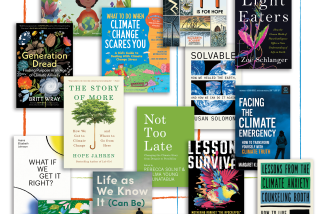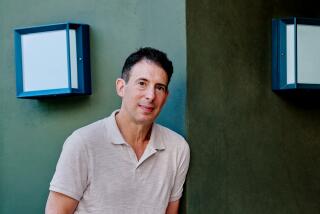Column: Bears thriving at Yosemite. Clear skies. Does coronavirus reveal a ‘World Without Us’?

Thanks to the coronavirus, Yosemite National Park is closed, the campgrounds are empty and the trails are void of people.
Skies have cleared over the smoggiest urban centers, wildlife runs free in parks, streets and plazas, flowers rise from the cracks of formerly well-trodden sidewalks and birdsong replaces the more motorized score of modern daily life. With much of the world’s population on COVID-19 lockdown, nature has never seemed more gloriously present — sublimely indifferent to human anxieties, eager to run riot over all the places in which it was once controlled, to return to the spaces from which it was expelled.
Meanwhile, in his Massachusetts home, environmental journalist Alan Weisman is getting many calls from people in many nations who all want to know the same thing:
Are we beginning to see the world without us?
“The World Without Us” is Weisman’s 2007 book, which imagines how the Earth would adjust should humans simply vanish one day. How long before the cities would return to meadows, the suburbs surrender to forests? How long before the bridges fall and the monuments crumble — before animals repopulated, some from the brink of extinction, and all trace of human progress vanished?
Not, in many cases, as long as you’d think. Which is why so many people want to know if the explosion of bears in Yosemite, the miraculously clear skies and the cacophony of birdsong everywhere mean that his thought experiment is coming true.
Bears, bobcats and other critters are roaming free in California’s most popular national park, closed to visitors since March 20
“I have been inundated by people sending me pictures of swans in the Venetian canals, or wild turkeys in the streets,” he told me. “A journalist who lives in Gurugram, which is No. 1 on the list of the world’s most polluted cities, just told me she is seeing blue skies. I even got an email from a nuclear physicist in Chernobyl, who I interviewed for the book, saying that whole towns look like Chernobyl now, silent and full of plant growth.”
In the last two weeks, Weisman had done interviews with outlets in India, Denmark, Argentina, Spain, Portugal, Iran.
“People are suspended between terror and wonder,” he said. “They’re terrified that this is all so fragile, but they also realize there are things we have been missing — the birdsong everyone is noticing, the beautiful skies — and that those things are important.”
For the record, Weisman does not think that COVID-19 will bring about the kind of scenarios he imagined in “The World Without Us,” but he does see parallels, in both reality and metaphor. One section of the book that many people have mentioned to him lately is a scene in which Jerry Del Tufo, a structural engineer who manages the bridges that link Staten Island to the mainland, explains how, without human vigilance, nature could vanquish even a model of modern design like the Bayonne Bridge.
“Every connection is vulnerable,” Weisman writes, and though he is describing a bridge, he is also describing the world with us.
“A lot of people realize that we are in this situation that looks so powerful, our economy, our society,” he said, “and now this one little infection comes out of one animal in one marketplace in one part of Wuhan and it can explode across the world that fast. It’s not even that lethal and yet look how it has brought us to our knees.”
At the same time, he said, “people talk to me about how it’s so peaceful and the streets look so nice when they’re not clogged. ... People are just moving back and forth between feeling really scared and feeling oddly exhilarated.”
Weisman, who has spent much of his life writing about the complicated and crucial relationship between our growing population and our increasingly battered environment, hopes that when humans emerge from our coronavirus quarantine, we do so with a greater appreciation for nature. And not just because of heart-lifting birdsong or the awesome beauty of Yosemite without lines of traffic.
Natural spaces, he said, provide barriers between humans and the microbes and diseases that exist in the wild. “National parks are so important because without them, and without all the forests and the jungles, we will be coming into more contact with viruses like COVID-19.”
Likewise, if we continue to push species to extinction, “well, the viruses have to go somewhere.”
Indeed, Weisman followed “The World Without Us” with “Countdown: Our Last Best Hope for a Future on Earth?” — a 2013 L.A. Times book prize winner that examines the perils of global population growth and the many ways it pushes us toward the chilling scenario of “The World Without Us.”
One of those ways is, obviously, a pandemic. Like many, Weisman hopes that this coronavirus will serve as a wake-up call to prepare for the possibility of a more lethal virus in the future.
More important, however, he hopes that the speed with which COVID-19 literally spanned the globe proves once and for all that we are all part of the same ecosystem and it is our personal and collective responsibility to protect it.
“We are living in the middle of a metaphor,” he said. “Anything that can happen anywhere can have an impact on us. We are 7.9 billion people so tightly bound by our travel and trade that a small, relatively weak virus can reach all of us in a matter of months. So it doesn’t matter if the smokestacks are in L.A. or Beijing or Tehran. The atmosphere does not care where it started.
“But information can travel just as fast as the coronavirus, and maybe now people will understand. A virus is invisible but deadly; climate change is invisible and even deadlier.”
When COVID-19 hit, Weisman was at work on a book about climate change; he should be in the midst of a very ambitious itinerary of international research trips that he will reschedule as soon as it is safe.
“I’m 73,” he said, “so why am I doing all this traveling? Because my species is facing a crisis. Because if we get past two degrees [increase in global temperature], the younger generations may not even get a chance at a full life cycle even without a pandemic.”
The book, he says, will look at reasonable expectations for the future, the obstacles that need to be overcome and the people who continue to work for a future in which everyone realizes the lesson of the coronavirus: That there is no us and them, there is only us.
The title of the book? “Hope Dies Last.”
More to Read
The biggest entertainment stories
Get our big stories about Hollywood, film, television, music, arts, culture and more right in your inbox as soon as they publish.
You may occasionally receive promotional content from the Los Angeles Times.











